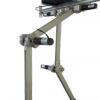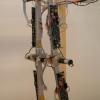Nonlinear control of underactuated mechanical systems
We focus on modelling and control of underactuated mechanical systems. Underactuated mechanical systems are mechanical systems having less actuators than the number of degrees of freedom. The simplest underactuated mechanical system is the Acrobot which has two degrees of freedom and one actuator placed between its rigid links. The Acrobot is one of the classical mechanical systems that have been studied extensively in the control area during the past few decades. Despite being seemingly a simple system, the Acrobot comprises many important difficulties when controlling the most challenging underactuated system - the walking robot. One of the most important issues in the study of the underactuated mechanical systems is an efficient control of these systems in application to reliable and economic walking or running. In particular, efficient algorithms for the Acrobot walking may be generalized to more general walking like configurations through their special decomposition.
A new control concept for a Acrobot was developed. We present the design of the asymptotical tracking of the prescribed trajectory generated by a suitable open-loop input of the Acrobot and the design of two observers for the Acrobot. Such a design is based on the partial exact linearization of the third order combined with a certain robust stabilization technique.
Namely, such an exact system transformation leads to an almost linear system where error dynamics along trajectory to be tracked is a 4-dimensional linear time-varying system having 3 time-varying entries only, the remaining entries being either zero or one. We have obtained the exponentially stable tracking in three different ways. First of them takes into the account bounds of time-varying entries and is based on applying LMI methods for quadratically stabilizing a linear system with polytopic uncertainty. The second approach takes into the account part of the information about the mentioned time-varying entries. The third approach takes into the account an information about these time-varying entries including their derivatives up to order 4.
We developed two observers for the Acrobot. Both of them are based on partial exact feedback linearization of order 3. A reduced observer for the Acrobot angular velocities is based on the respective angles measurements. A high gain observer for the Acrobot angular velocity and angle is based on the other angular velocity and angle measurement. Both of them were combined with developed feedback control of the Acrobot.
For a purpose of cyclic walking we developed the algorithm for computing of a cyclic walking like trajectory based on a impact map of the Acrobot. Notice, that such a design is not an easy task because the walking trajectory initial conditions are changed along the single step into different end conditions and these should be subsequently mapped by the impact map into the same initial condition for the second step.
The proposed feedback control with observers is then demonstrated by the exponential tracking of the walking-like trajectory of the Acrobot. Besides analytical and numerical proofs, our approach is supported by numerical simulations and illustrated by Acrobot movement animations.
The nature extension of the almost finished research of the Acrobot depicts in adding of knees into Acrobot's legs. The new system, in the literature called as the 4-link, is controlled by virtue of the Acrobot embedding into the 4-link. I.e. the angle in the hip is controlled as it would be an Acrobot angle whereas angles in knees are controlled using constraint functions with dependance on the angle in the hip. Therefore, the already developed control algorithms for the Acrobot were simply adapted and they are able to control the 4-link too. Moreover, the observer design and multi-step walking trajectory design for the 4-link are based on the embedding method as well.


